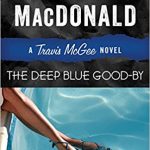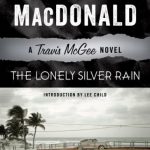by Tim Suddeth
John D. MacDonald was one of the most prolific and acclaimed American writers. He is best known for his Travis McGee series and the many TV shows taken from his writing. Stephen King praised MacDonald as “The great entertainer of our age, and a mesmerizing storyteller.”

But he cut his chops by writing for numerous pulp magazines in the 30s and 40s. He wrote over 500 short stories for over 20 magazines and under several pseudonyms. Between the years 1945 to 1986, he sold an estimated 70 million books, third in detective fiction behind Perry Mason and Mickey Spillane.
Early Years, Education, and Military
John D. MacDonald, known to his friend as John D., was born in 1916 in Sharon, Pennsylvania. When he was 18 (1934), he spent several weeks in Europe, creating a love for travel and photography.
He attended Wharton School of the University of Pennsylvania, leaving during his sophomore year. He later went to Syracuse University, where he met his future wife, Dorothy Prentiss. They married in 1937 and he graduated from Syracuse in 1938. In 1939, he got his MBA from Harvard University. The education he received in business and economic shows in some of his later work.
MacDonald’s first short story, “G-Robot” appeared in the July 1936 Double Action Gang magazine. But it was another ten years before he had another work to appear.
In 1940, he received a direct commission as a first lieutenant of the Army Ordnance Corps. During World War II, he served in the Office of Strategic Services in the China-Burma-India Theater of Operations. He served until September 1945, when he was discharged as a lieutenant colonel.
Pulp Fiction Career
On The Trap of Solid Gold website, Steven Scott has done every John D. MacDonald fan a huge favor in accumulating old and out of print interviews and articles about the talented author. Many of his posts helped me create a much clearer picture of the man.
In an article dated October 7, 1957, from the Tampa Morning Tribune, Joann Scheb writes about how his wife Dorothy played a large role in getting his career started.
During WWII, Army life in India bored John, and he didn’t like having all his letters to his wife censored. He wrote his first short story just for their own amusement. Dorothy liked it, re-typed in manuscript form, and sent it to a slick magazine.
Instead of getting a formal rejection letter, or never getting a reply, she received a nice personal letter saying that, although they liked the story, they had just published a similar one and did they have anything else. She didn’t know, and the Army had moved John. It was six months before she heard from him again.
In the meantime, she sent the story out to a lesser magazine. And it sold. For $25. It was enough for them to cancel all business appointments that had been based on his Harvard degree and gamble his four months of accumulated leave while he tried his luck with the typewriter. (OaM’s opinion: Writers are crazy.)
For four months, he wrote madly, turning out millions of words that were all rejected. He generated 800,000 words while typing 14-hours a day, seven days a week. Dorothy, an art school major, turned her talents to painting furniture. At the end of the four months, he was just beginning to sell to a pulp magazine. He got a menial job, and she taught painting. The rest of his time, he spent at the typewriter.
He sold his next story, “Cash in the Coffin”, to Detective Tales in May 1946. The magazines paid from half-a-cent to three cents a word. From 1946 to 1951, he placed dozens of stories each year with various pulp magazines. Sometimes, an issue would comprise only his stories under different names. His stories included adventure, detective, fantasy, science fiction, sports fiction, and westerns.
In 1950, it became apparent that pulp magazines were on their way out. He turned his attention to writing novels and placed his first one with Fawcett Gold Medal, The Brass Cupcake. From then on, he only wrote under his name and released over forty books in the next fourteen years.
Travis McGee
John D. MacDonald created the Travis McGee series at the urging of the publisher. He was unsure how it would go. He waited until he had three novels completed before he submitted them. This does not count the first novel that he burned because it wasn’t good enough. The first three books came out a month apart.
three novels completed before he submitted them. This does not count the first novel that he burned because it wasn’t good enough. The first three books came out a month apart.
At first, he named his Dallas McGee. But then President John F. Kennedy was assassinated. A friend learned he was struggling for a new name and suggested that he look at the Air Force bases in California, and he chose Travis Air Force Base in Fairfield, California. He chose to set the stories on the other side of the state than where he lived in Sarasota Siesta Key in case they ever became popular and so they wouldn’t interrupt his privacy.
The first Travis McGee novel, The Deep Blue Good-by, was published in 1964. The last novel, The Lonely Silver Rain, came out in 1984. He wrote twenty-seven Travis McGee adventures, all with a color theme in the title. Someone suggested that he do that so that people passing his books in an airport can quickly remember which ones they’ve read and haven’t read.
Many have called McGee the first great modern Florida adventurer. He has set a standard by shedding light on the development troubles in the state.
Carl Hiaasen, in an introduction to the 1990s edition of The Deep Blue Good-by, wrote, “Most readers loved MacDonald’s work because he told a rip-roaring yarn. I loved it because he was the first modern writer to nail Florida dead-center, to capture all its languid sleaze, racy sense of profit, and breath-taking beauty.”
Writing Process
In the December 14, 1969, five years after beginning the McGee series, John D. MacDonald gave an interview to Mike Baxter for Tropic, the Herald’s Sunday Supplement where he described his writing process in the height of the Travis McGee fame.
He wrote on a beige IBM Selectric typewriter seven-to-nine hours a day. He would write until lunch and then again until the cocktail hour, each day but Sunday. His study was in a small upstairs room called his Ivory Tower. His wife said in the previous interview, “When he comes down for lunch and I see he’s still up there mentally, I know it’s not time for small talk.”
He never discussed his plot problems with her. Sometimes she read the proof, but never the manuscript. He did his own writing because he writes as well as he can the first time, and the script usually came out ready for his agent.
Baxter wrote how, while he was completing the twelfth McGee novel, he was working on three other novels, moving from one to another at the first sense of boredom. He wrote without an outline, having determined the beginning and ending and wading through the middle.
He wrote on expensive 25-pound bond paper. MacDonald explained, “I think the same situation is involved as with painting and sculpture. If you use the best materials you can afford, somehow you have more respect for what you do with it.”
He seldom edited with a pencil or pen. “I rewrite by throwing away a page, a chapter, half a book, or go right back to the beginning and start again.”
The life and writing process of John D. MacDonald @TimSuddeth @OpeningaMystery #amwriting #mystery Share on XBaxter said he was a happy writer, unlike the stereotype of most writers. “I enjoy the hell out of writing,” MacDonald said, “Because of the rare times when it really works good. It’s like an Easter egg hunt. Here’s fifty pages, and you say, “Oh, Christ, where is it” Then on the 51st page, it’ll work. Just the way you wanted it to, a little better than anything in that same area ever worked before. You say, ‘Wow! This is worth the price of admission.’”
Lucky for us, MacDonald had a lot of those times. And, also lucky for us, he stuck through the early work to give us the masterpieces he developed.
MacDonald passed away in 1986 at seventy. In 1972, the Mystery Writers of America had given upon him its highest honor, the Grand Master Award for lifetime achievement and consistent quality. After being a long-time fan when I was younger, I think the award was well deserved.
5 responses to “John D. MacDonald”
Thanks for a look at a favorite author. I started reading his work when I was young enough to just think it sprang from the universe rather than being the hard work of a person, and somehow never mentally got past that to wonder about his life.
I think we often do that with our favorite writers. Thanks for reading.
I applaud what JDM said about quality materials. Heavier paper and even an occasional switch to a fountain pen helps me with my first drafts.
There used to be an entire fanzine devoted just to MacDonald.
[…] with a theme had always fascinated her, like John D. MacDonald titles which include colors. She decided to use titles that included the alphabet, never realizing […]
another great post and I have read all of his Travis McGee’s too — but so many years ago. Must reinvestigate!